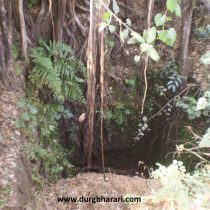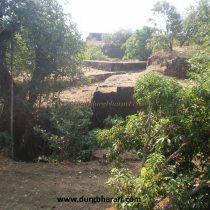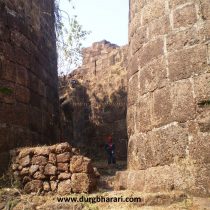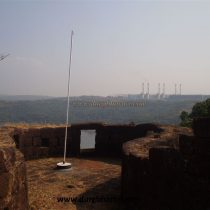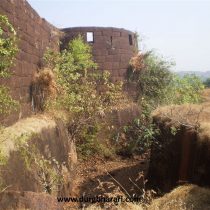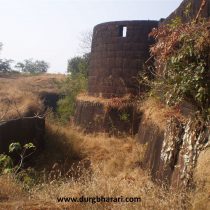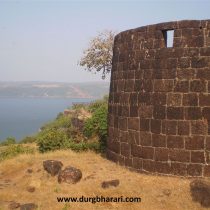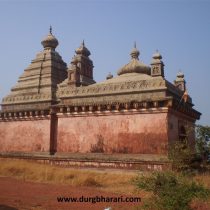GOPALGAD
TYPE : COASTAL FORT
DISTRICT : RATNAGIRI
HEIGHT : 260 FEET
GRADE : EASY
In ancient times, Dabhol was a famous port on the west coast. Commercial shipping used to take place from Dabhol Bay to Chiplun. To control this trade route, Anjanvel aka Gopalgad was built at the mouth of the creek and Dabhol fort was built inside the creek to protect the port. To visit this fort located on a hill on the shores of Dabhol creek, you have to reach Anjanvel in Guhagar taluka. The distance from Mumbai to Guhagar is 270 km and the distance from Guhagar to Gopalgad fort located in Anjanvel village is 14 km. Gopalgad fort is located above Anjanvel village. If you come by bus from Guhagar, it takes half an hour to reach the fort from Anjanvel village, but you can reach the plateau gate directly by private vehicle. There are two entrances to the fort, one on the ramparts of the fort and the other on the sea.
...
Currently, the embankment has been breached and a paved road has been constructed. An iron gate is built at the place where the ramparts are broken. But if you want to enter the fort through the main gate of the fort, you can turn to the right side of the ramparts and go to the main gate on the western ramparts. The entrance is built on a winding path (gomukhi) between two bastions. There is a mango orchard inside the fort and the entire fort is covered with these trees. Upon entering through this door, you can see a deep dry well on the left. In front of this well, there is a large cistern near the ramparts, and steps are built to descend into it. Remains of a building with rectangular shaped walls can be seen near this cistern. There are steps to climb to the curtain wall and the entire fort can be reached from the curtain wall. Gopalgad fort is built on a 300 feet high hill with a strong rampart on both sides of the hill. Spread over about 7 acres, most of the ramparts of this fort are still in good condition. In this part of the fort was an inscription carved in Persian in 1707, which is no longer in its place. This inscription has been read and its Marathi meaning is- if someone starts construction and dies while it is going on, doesn’t the owner of this construction go to others? Only God is timeless. Everything else is mortal. Our king had planned to build this fort, but he died before its construction had been completed. Date - 10 Hijri, the year 1119 i.e 1707 AD. The fort is surrounded on three sides by the sea and a deep moat has been dug outside the plateau. The ramparts in this area are about 20 feet high and 8 feet wide and have 15 bastions. These bastions have round quadrangle structures build out of stone for cannons. Walking from the shore, you can see the storehouses built for accommodation and storage. While walking from the ramparts, one can see Vashishti river creek, Dabhol project, Veldur, Talkeshwar lighthouse, and the sea spread in the distance. In the central part of the fort, you can see two dry wells and quadrangle structures of some houses. The lower part of the citadel is known as Padkot. At the end of this Padkot are arches on the seaside. Adjacent to this arch is a secret door to get out in case of emergency and in front of it is a cistern filled with mossy water. The fort has another door to enter through the sea. Outside this door, there is a well with steps carved out of rock and the water in it is drinkable. The ramparts leading from here to the citadel have been severely damaged. Information about Gopalgad aka Anjanvel fort and the developments in the area can be found in the Document of Anjanvelchi vahiwat. Anjanvel fort was built at the mouth of the Vashishti river in Anjanvel village during the Adilshahi period in the 16th century. Recognizing its importance due to its strategic location, the local authorities changed the original fort from time to time and strengthened it. During the Dabhol invasion of 1660, when Shivaji Maharaj conquered the fort of Anjanvel from Adilshah, it must have been rebuilt to some extent. During this period a dock was built here for the navy and the fort may have been named Gopalgad. The fort was conquered by Siddi Kharyat Khan of Janjira in 1699 and remained under Siddi's control for the next 46 years. During this period, the Padkot of the fort was built and the inscription mentioned above was carved. The name of Siddisat is engraved on this inscription. Some historians believe that it was renamed Gopalgad after Tulaji Angre conquered the Anjanvel fort from Yakutkhan in 1745. Gopalgad was conquered in 1756 by Peshwa chief Ramji Mahadev Biwalkar. After the battle of Panipat, Gopalgad was under the control of Sadashivbhau's duplicate for 6 months. After that, Gopalgad remained under the control of Marathas till 1818. On 17 May 1818, the fort was conquered by the English Colonel Kennedy from the Marathas. Until 1829, the fort had a British military base. In a survey from 1862, it is mentioned that there are 88 cannons in this fort but today not even a single cannon can be seen in the fort.
© Suresh Nimbalkar

